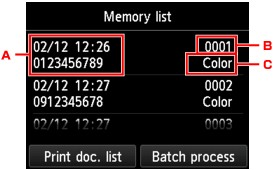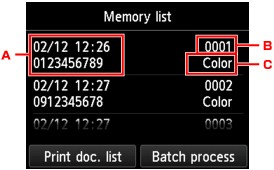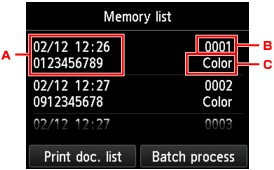Document Stored in Machine's Memory
| Article ID: ART116468 | | | Date published: 05/12/2015 | | | Date last updated: 08/15/2015 |
Description
Document Stored in Machine's Memory
Solution
| Document Stored in Machine's Memory ID : 8202129000 _ EN _ 1 | |
| Solution | If the sending faxes is not complete or the machine was not able to print the received faxes, these faxes are stored in the machine's memory. If an error occurred during a fax transmission, the document is not stored in the machine's memory. In the following cases, the machine is not able to print the received fax and will automatically store the fax in its memory.
You can print or delete the faxes stored in the machine's memory. You can also save the received faxes stored in the machine's memory on the USB flash drive or forward the received faxes stored in the machine's memory to the shared folder on the computer.
-> See [ Printing a Document in Machine's Memory ] in this page.
-> See [ Deleting a Document in Machine's Memory ] in this page.
-> See [ Saving a Document in Machine's Memory to USB Flash Drive ] in this page.
-> See [ Forwarding a Document in Machine's Memory to Shared Folder on the Computer ] in this page.
Printing a Document in Machine's Memory You can print a specified document in the machine's memory or print all the documents in its memory at a time. When printing a specified document, you specify it by its transaction number. If you do not know the transaction number for your target document, print the list of documents (MEMORY LIST) first. 1. Make sure that the machine is turned on. 2. Load paper. 3. Flick the HOME screen, then tap  FAX. FAX.The Fax standby screen is displayed. 4. Tap Function list. The Function list screen is displayed. 5. Tap Memory reference. The memory list is displayed.  A. Date and time of transaction and fax/telephone number B. Transaction number (TX/RX NO.) A transaction number from "0001" to "4999" indicates a document being sent. A transaction number from "5001" to "9999" indicates a document being received. C. Color information Color is displayed for color transmission/reception. Nothing is displayed for black & white transmission/reception.
6. Select a print menu.
You can print a list of the documents in the machine's memory by tapping Print doc. list. When the print confirmation screen is displayed, tap Yes. The printing starts. MEMORY LIST shows the transaction number of the unsent or unprinted fax (TX/RX NO.), transaction mode, recipient's number, and the date and time of the transaction. A transaction number from "0001" to "4999" on MEMORY LIST indicates a document being sent. A transaction number from "5001" to "9999" on MEMORY LIST indicates a document being received.
Select a document to print on the Memory list screen, tap Print specified document.
The confirmation screen to select whether to print only the first page of the document is displayed. If you select Yes, only the first page of the document will be printed. The document is still stored in the machine's memory. If you select No, all pages of the document will be printed. The screen to confirm whether to delete the printed document in the machine's memory is displayed after printing.
Tap Batch process then tap Print all RX documents. When the print confirmation screen is displayed, tap Yes. All the documents in the machine's memory are printed. Each time a document is printed, the screen to confirm whether to delete the printed document in the machine's memory is displayed. If you tap Yes, the printed document in the machine's memory is deleted. Deleting a Document in Machine's Memory You can delete a specified document in the machine's memory or delete all the documents in its memory at a time.
1. Make sure that the machine is turned on. 2. Flick the HOME screen, then tap  FAX. FAX.The Fax standby screen is displayed. 3. Tap Function list. The Function list screen is displayed. 4. Tap Memory reference. The memory list is displayed.  A. Date and time of transaction and fax/telephone number B. Transaction number (TX/RX NO.) A transaction number from "0001" to "4999" indicates a document being sent. A transaction number from "5001" to "9999" indicates a document being received. C. Color information Color is displayed for color transmission/reception. Nothing is displayed for black & white transmission/reception.
5. Select a delete menu.
Select a document to delete on the Memory list screen, tap Delete specified doc..
The confirmation screen is displayed. If you select Yes, the specified document is deleted from machine's memory.
Tap Batch process then tap Delete all documents. The confirmation screen is displayed. If you select Yes, all documents are deleted from machine's memory. Saving a Document in Machine's Memory to USB Flash Drive You can save the received faxes stored in the machine's memory to the USB flash drive as PDF files using the operation panel of the machine. You can save a specified document in the machine's memory to the USB flash drive or save all the documents in its memory to the USB flash drive at a time.
1. Make sure that the machine is turned on. 2. Insert the USB flash drive into the USB flash drive port. 3. Flick the HOME screen, then tap  FAX. FAX.The Fax standby screen is displayed. 4. Tap Function list. The Function list screen is displayed. 5. Tap Memory reference. The memory list is displayed.  A.Date and time of transaction and fax/telephone number B.Transaction number (TX/RX NO.) A transaction number from "0001" to "4999" indicates a document being sent. A transaction number from "5001" to "9999" indicates a document being received. C.Color information Color is displayed for color transmission/reception. Nothing is displayed for black & white transmission/reception.
6. Select a save menu.
Select a document to save on the Memory list screen, tap Save specified document.
Tap USB flash drive as the destination. The specified document is saved on the USB flash drive.
Tap Batch process then tap Save all RX documents. Tap USB flash drive as the destination. All documents are saved on the USB flash drive.
Forwarding a Document in Machine's Memory to Shared Folder on the Computer You can forward the received faxes stored in the machine's memory to the shared folder on the computer as PDF files using the operation panel of the machine. You can forward a specified document in the machine's memory to the shared folder on the computer or forward all the documents in its memory to the shared folder on the computer at a time.
1. Make sure that the machine is turned on. 2. Make sure that the machine is connected with the destination computer. 3. Flick the HOME screen, then tap  FAX. FAX.The Fax standby screen is displayed. 4. Tap Function list. The Function list screen is displayed. 5. Tap Memory reference. The memory list is displayed.  A. Date and time of transaction and fax/telephone number B. Transaction number (TX/RX NO.) A transaction number from "0001" to "4999" indicates a document being sent. A transaction number from "5001" to "9999" indicates a document being received. C. Color information Color is displayed for color transmission/reception. Nothing is displayed for black & white transmission/reception.
6. Select a forward menu.
Select a document to forward on the Memory list screen, tap Save specified document.
Tap Destination folder as the destination. Tap a destination folder to forward the specified document to the shared folder on the computer.
Tap Batch process then tap Save all RX documents. Tap Destination folder as the destination. Tap a destination folder to forward all documents to the shared folder on the computer.
|
SIMS Doc Id
8202129000
